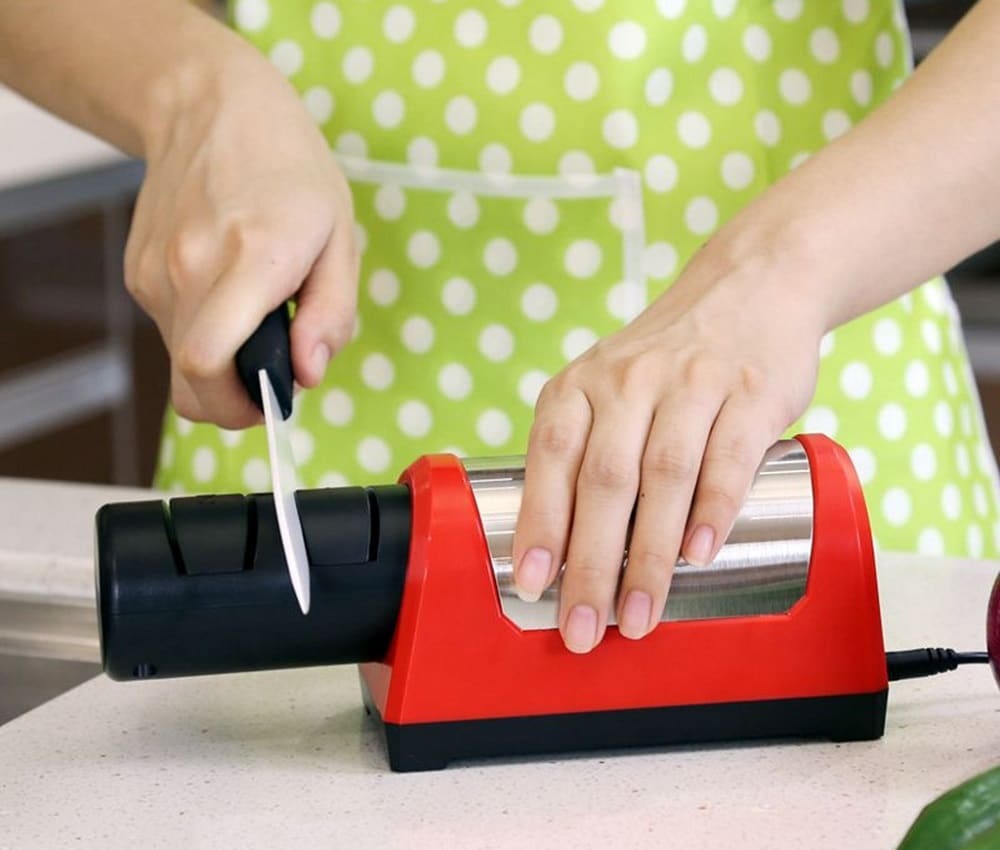How to sharpen a ceramic knife
Ceramic knives have firmly entered the everyday life of a modern person, this became possible due to the unsurpassed quality of the cut, their lightness and compactness. But even such a modern kitchen accessory may need sharpening over time.

We will tell you further about whether ceramic knives are sharpened, and most importantly - how they do it.
Do I need to sharpen a ceramic knife
Sharpening is used to increase the sharpness of the incisal edge, so if the cutting surface has ceased to cope with its tasks, or does not do it as efficiently as before, of course, it must be sharpened.

There are many nuances when working with ceramics. Its cutting material is quite fragile and light, so if you decide to sharpen it yourself, you cannot do without our recommendations.
How to sharpen a ceramic knife
Sharpening of a ceramic knife is most often done with the following devices:
- grinding musat;
- specialized whetstone;
- mechanical sharpener;
- electric sharpener;
- diamond-based paste;
- grinder.

Each of the proposed methods can bring both benefits and harm to the ceramic cutter. The main thing to remember is that the surface material is quite fragile, so you shouldn't put unnecessary efforts when carrying out such work.
Musat for ceramic knives
Musat is a file with a cylindrical working surface. For ceramic products, it must have a fine surface structure so as not to damage the fragile material.

Sharpening is done by positioning the sharpening surface parallel to the cutting edge. We move the knife along the musat with smooth movements from ourselves. First, the surface closest to the handle is sharpened, gradually moving towards its tip.
Note! The main thing in such sharpening is not to damage the surface, so you should not apply unnecessary efforts, it is better to spend more time, but get the desired result without loss.
Special whetstone
Essentially the same sharpener, but in the form of a rectangular stone and most often with two sides of different grain sizes. The harder side is used for pre-sharpening and working with coarse notches, if any.
The sharpening stone will return the knife to its original sharpness.
The other side is responsible for finishing the cutting surface and bringing it to the sharpest possible state.
Note! Before sharpening, it is recommended to soak such a stone in water for 30-40 minutes in order to reduce the friction of the ceramics on the surface of the sharpening bar.
Hand sharpener
You can buy such a device at any hardware store. Sharpeners are single or double-sided.Before buying, it is recommended to pay attention to the compatibility of the product with ceramic knives, on some of the sharpeners the stone may have a too rough surface and is not intended for working with ceramics.

Typically, this blade sharpener has slots. We insert the blade into them and begin to sharpen with smooth movements, parallel to the cutting edge. To be sure of the quality of sharpening, you can try using the knife on any product, best of all on a soft fruit or vegetable.

And if you are satisfied with the result, the sharpening is considered complete.
Electric sharpener
A more convenient and functional version of a manual sharpener. Before purchasing, you also need to make sure that the selected model is compatible with ceramic knives.

The sharpening is done in the same way - we insert the blade into the grooves and start the mechanism. We drive the cutter over the grindstone with smooth movements, avoiding too much effort. Such sharpeners can be designed for both two- and one-sided sharpening.

Also, in some specialized models, two types of grindstone are provided - for main and finishing, with such a unit you can achieve the best results.
Diamond paste
This paste contains finely dispersed diamond grit. For the main sharpening, the material is not used, but as a final step to give the surface the highest sharpness, it will do just fine.

The paste is applied to the surface of any smooth material (most often paper or leather is used, the fabric easily absorbs the paste and is not recommended for use) and the blade is finished.
Note! When carrying out such an operation, you must be extremely careful to prevent skin cuts and other injuries.
Special machine
A sander can also come in handy if you need to sharpen a ceramic knife at home. But due to the high fragility of the surface of such a material, you should first purchase grinding wheels based on diamond abrasive.

The particle size should be no more than 80 microns for the main sharpening of the blade and half as small (40 microns) for the final stage of work.
Note! It is strictly forbidden to carry out machining at high machine speeds.
When sharpening, the blade should only be pressed lightly against the stone surface, especially during the main sharpening stage. The wheel must rotate perfectly flat, without distortion, otherwise it can cause chips to appear on soft ceramics.

We sharpen the knife in the same way as with hand tools - moving from the handle to the tip of the blade. For each side, a separate sharpening is performed, one of the most important factors is to carry out work in strict accordance with the existing factory.

If you apply the wrong angle, the blade will become dull and cannot be restored at home.
Sharpening options and rules
Depending on the type of blade, certain sharpening rules must be followed. There are some nuances when working with single and double-sided blades. We will consider them further.

One side
The earliest Japanese ceramic knives had only one side.Their main purpose was to finely chop soft foods and fish. Later, double-sided models also appeared in the range.

In any case, it is important to know not how to sharpen a ceramic knife, but how to do it correctly. We perform work with minimal effort. When sharpening a blade on one side, manual and automatic sharpeners cannot be used if they do not provide such an opportunity, and most often, especially in the most economical products, there is only two-sided processing.

The main and most important rule that must be adhered to is not to exert too much force on the blade. Also, when sharpening, it is necessary to ensure that the ceramic surface does not heat up too much, this can cause it to chip.

From two
Double-sided sharpening saves a considerable amount of time, because to return the sharpness to a ceramic cleaver, you need to devote much more time and diligence than for metal products.
The easiest way is to sharpen the knife from both sides in an automatic sharpener. In this case, it is enough just to control the applied efforts and not to overdo it.

If you do not have an automatic device at hand, you can use manual devices, for example, a musat, or a sharpening stone. In this case, the sharpening of the double-sided knife turns into a combination of two separate single-sided ones.

To achieve the best result, it is recommended to sharpen in two stages - the main one with a coarser grindstone and the finishing one with a fine abrasive.
Advantages and Disadvantages of a Ceramic Knife
The main advantages of ceramic knives include:
- high severity;
- resistance to absorption of foreign odors and moisture;
- lack of oxidative processes when interacting with products.
It is for the absence of any interaction with products that ceramic knives are so highly valued, especially among allergy sufferers.

But at the same time, ceramics has several disadvantages:
- High fragility. One wrong move, working with too large bones inside vegetables or fruits, or trying to cut too hard material can result in the blade chipping.
- The ability to sharpen the blade only with special diamond compounds.

The rather high softness of the material makes it not such a versatile tool as metal, but with proper handling, you can achieve an excellent result without any change in the original taste and aroma of the products, which is what the metal brothers sin a lot.
Ceramic knife care rules
The basic rules of care are reduced to protecting the knife from falling, this will preserve the integrity of its blade for a long time.

The knife does not require any special approach to itself - the ceramic surface is environmentally friendly, does not absorb any odors, after working with meat, for example, it is enough to refresh the knife under running water, and you can cut fruits or vegetables.

It is best to store such knives separately from metal ones, ideally in personal plastic cases.

The tips described in this material on how to sharpen a ceramic knife at home will help maintain the sharpness and quality of the cut for a long time. If, at the same time, you follow the simple rules for the operation of such knives, you can provide them with a long service life.
Video: how to properly sharpen a ceramic knife







